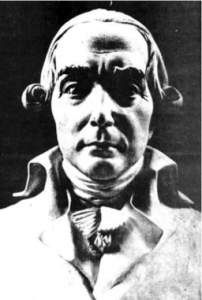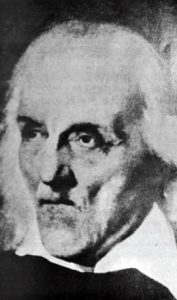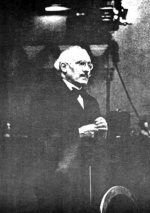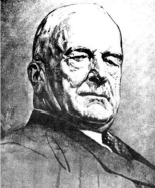Part II: Italian Immigration and Settlement
Chapter 4: Italians in America: The Formative Years (1600 – 1880)

The Age of Exploration found not a few Italians in the ranks of those who opened up the Americas for habitation and colonization. Columbus, Cabot, Vespucci, Verrazzano, Tonti, Kino all prepared the way for permanent settlement in North America. While their discoveries excited the imagination of other Italians, of other Europeans, it was the English whose well-organized and quickly successful settlements promoted the actual migration of non-English Europeans to America’s coastal regions. Some of those early colonists in the 17th and 18th centuries were Italians seeking freedom of religion or political and economic opportunities. Their story is an important one frequently neglected in the narrative of American history during these formative years.
Early Settlers
To understand Italian colonization efforts during the 16th and 17th centuries it is necessary to realize that many Italians were already dispersed throughout Europe, living in communities in England, Germany, Flanders, France and Spain. Although England was not the only location of early Italian settlers it was perhaps the most important community from which Italian colonists were drawn. A major obstacle in tracing these colonists is that many were Italian born but naturalized in England. The following list, taken from the Huguenot Society of London Publications reveals that all of the following “English” persons were naturalized and anglicized Italians:[1]
John Gray
Sir John Portinary
John Gillam
Doctor Sesar, physician
Giles Corner
Gaspyn Sonhall, physician
Peter Foxe
The custom of changing names, either voluntarily or during the naturalization process, is apparently not a recent one.
The nascent English colonies, once having survived their first winters of discontent, now were in need of artisans and craftsmen to create some form of cultural permanence in their communities. As early as 1610 Virginia received several Italian craftsmen at the invitation of the colony. In 1622 Venetian glassmakers, working in England, were brought to Jamestown to teach and to promote their trade. At about the same time Italians were brought as vignerons to begin grape cultivation. Obviously the colonies were impressed with these early settlers because they continued to encourage Italian migration. By 1632 a few Italians had settled in Catholic Maryland and soon created a haven for Italian refugees. A declaration of the Lords Proprietaries of Maryland in 1649 encouraged Italians to migrate to the colony and authorized the governor “from time to time to grant lands unto any persons for French, Dutch, or Italian descent upon the same terms and provisos as those of British or Irish descent.”[2]
The first sizable Italian immigration to North America involved certain religious refugees, the Waldensians, who migrated from Holland in 1657. About 167 Waldensians were brought over and settled in New Castle, Delaware, as well as in New Amsterdam. Later in the 17th century other displaced Italian Waldensians were enlisted in a plan to colonize Virginia. Money for their transportation to the colony from their temporary location in Switzerland was furnished by the English government.
A plan to settle the English province of East Florida with Southern Europeans ended in disaster in 1767. The settlement of New Smyrna was set up under feudal conditions for a thousand Italians, Greeks and Minorcans. Unsanitary conditions, harsh overseers and an outbreak of malaria ended in a revolt by the Italians led by one Carlo Forni. He and a group of 30 tried to seize a boat and escape to the Spanish Keys and freedom. They were captured and hanged by the British as pirates. On the Eve of the American Revolution most of the remaining Italians had died of scurvy or malaria, or had escaped to St. Augustine or the Bahamas.
It is ironic that the first Italians to come to the New World stood on the decks of the ships that they captained while later their countrymen would arrive as refugees or indentured servants, huddled together as steerage passengers in the decks below. From the very beginning, however, Italians participated in the economic and artistic life of this country. Although a comparatively small number of Italians, perhaps 2000, were in America at the time of the Revolution, these transplanted Italians did actively participate in the creation of this new country.
Philip Mazzei
In the third quarter of the 18th century one man stands out among the dozen or so prominent Italians active in the affairs of North America and the Revolution. He was Philip Mazzei, a Florentine nobleman and medical student who inspired Jefferson and Thomas Paine in their political writings. Indeed, it is not an exaggeration to label Mazzei as an “assisting Founding Father” for his impact upon the philosophical principles of this country.
Mazzei came to America in 1773, a cosmopolitan traveler alone in a thoroughly English political climate. He had lived in England for eighteen years and was aware from first-hand experience how careless that government was of its people. American colonies were humbly petitioning for the redress of certain grievances; but Mazzei immediately advocated a complete break with the island which ruled the continent. This idea in particular was later picked up and elaborated upon by another immigrant, Thomas Paine, in his pamphlet Common Sense, written in 1776.
In 1773 Mazzei landed with a small party of settlers in Virginia some four miles from Williamsburg and was met by some of the colony’s leading citizens, including Washington. Mazzei was invited to spend a few days at Monticello and Jefferson showed Mazzei a 400-acre tract adjacent to his land which was for sale.
At a most fortunate moment in American history Jefferson and Mazzei became political collaborators and close friends.
Philip Mazzei wished to join in the affairs of this country immediately but Patrick Henry insisted that he could best help the cause with his pen and oratory. As a contributor to the Virginia Gazette, Mazzei used the pen name “Furioso” and had his lines translated by Jefferson (who, incidentally, spoke, read and wrote fluently in Italian). In one issue Mazzei wrote and Jefferson translated the following passage:
All men are by nature equally free and independent. Such equality is necessary in order to create a free government. All men must be equal to each other in natural law . . .[3]
Although Mazzei never wrote the words “all men are created equal,” the exact terminology of Jefferson’s Declaration, it is obviously Mazzei who furnished the concept, the philosophy, which the Virginian paraphrased in the Declaration of Independence.
In other ways too, Mazzei was instrumental in the Revolution. His letters to influential friends in France helped develop French assistance to the colonies. He obtained naval support from the Netherlands and Spain and funds from European friends. From Paris in 1780 John Adams wrote to Jefferson about Mazzei:
As far as I have had the opportunity to see and hear he has been useful to us. He kept good company and a good deal of it. He talks a great deal, and is a zealous defender of our affairs. His variety of languages and his knowledge of American affairs give him an advantage which he does not neglect.[4]
Writing to Patrick Henry on June 12, 1783, Adams further commented: “Mr. Mazzei has uniformly discovered in Europe an attachment and zeal for the American Honor and Interest, which would have become any native of our country.”[5]
Yet Mazzei was not accepted by all Americans. Benjamin Franklin refused to accept his credentials as a representative from Virginia. He felt that the Congress, not the states, should send agents abroad, and that they should be Americans. Mazzei was understandably indignant but this setback did not weaken his attachment to America although he did feel that he was never quite trusted in the colonies because he was a Catholic and a foreigner.
In 1785 Mazzei left America and returned to Europe, where he was granted Polish citizenship in 1791. For the remaining 25 years of his life he traveled throughout Europe, remaining in correspondence with Jefferson, Madison and the other “Founding Fathers.” In 1805 Jefferson requested Mazzei to commission the great Italian sculptor Canova to work on the new Capitol in Washington. Instead Mazzei sent two lesser known Italian sculptors to Jefferson and wrote to the Vice President: “I thank you with all my heart . . . that I have the honor and privilege of being placed in a position to do something for my dear adopted fatherland.”[6]
When Philip Mazzei died in Pisa in 1816 Jefferson recalled that “his esteem in this country was very general; his early and zealous cooperation in the establishment of our independence having acquired for him here a great degree of favor.”[7] During his life he proposed radical solutions to pressing problems and inspired American leaders to decide in favor of revolution and separation. In a self-effacing way he promoted America wherever he went, in his speeches as well as in his four-volume History of the United States, written in 1788. Yet Mazzei is little remembered today except by those who choose to investigate beyond the traditional narratives of the American past.
Italians and the American Revolution
It is difficult to ascertain how many Italians participated in the Revolution; their roles are usually not included in standard histories of the struggle. We do know of a few Italians such as Captains Richard Talliaferro and Ferdinando Finizzi who fought for the Americans. Captain Cosmo Medici (“Madacy” according to the Continental Congress Commission) was court martialed in 1777 but exonerated and later promoted. Colonel Lewis Nicola, of mixed French and Italian descent, is remembered as the officer who advanced the notion that George Washington ought to be made King. On the rolls of the regiments and naval registries of the thirteen colonies are found scores of purely Italian names.
Francesco Vigo
The name of Captain Francesco Vigo (1747-1836) has recently been recovered from historical obscurity for his efforts in assisting the Americans’ acquisition of the Old Northwest Territory.
As Giovanni Schivio insists, “without Vigo, [General George Rogers] Clark would have remained an obscure frontier raider.”[8] It was Vigo who financed several of Clark’s expeditions, and influenced the French inhabitants of the region to assist Clark against the British. It was Vigo who personally acted as a spy for Clark on his mission against the British fort at Vincennes.
Francesco Vigo was a very successful Italian fur trader in the Midwest who offered his services and his money and risked his life for General Clark in 1778. The objective was Fort Kaskaskia. Vigo loaned Clark about $1500, influenced others to make loans of $7000, and guaranteed Clark’s supplies: “Buy what you want; give orders on me and I will pay for them.”[9] The troops were paid, the supplies were purchased and the fort was taken in 1778.
In 1779 Vigo was captured by Indians while on a spying mission to the British at Vincennes, the key to the Northwest Territory. Taken to Vincennes, Vigo pursuaded the British commander to free him with the help of the fort’s French population who refused to supply the British unless their friend was released. Set free, Vigo made his way to General Clark with information on the fort’s supply and the situation of the garrison. Fort Vincennes was taken in 1779.
After the war Vigo suffered severe financial losses. He had personally loaned Clark a total in excess of $9000 but refused to demand repayment. He did receive 400 acres of land worth some $500, the same as any resident of Vincennes who had taken the oath of allegiance to the United States. In 1800 he was made a Colonel in the Indiana state militia. Thirty six years later Vigo, aged 86, died in utter poverty, his total property totaling $77.62, an amount which did not even cover funeral arrangements. He never collected the money owed to him by Congress, although a settlement was made with his heirs in 1876.
It is impossible to estimate the effect which an incident can have upon the outcome of a military campaign. There is no question, however, that Francesco Vigo did play an important role in the opening up of the Northwest Territory for American settlement in that region. Again citing Schivio, it is quite probable that Ohio, Indiana, Illinois, Wisconsin and Michigan would today form part of Canada instead of the United States if Fort Vincennes had not been taken by General George Rogers Clark. And without Vigo’s personal assistance in that mission the fort would not have been taken.
Italians and the Formations of American Culture
Before the stream of Italian travelers to America had opened into that flood of humanity known as the Great Immigration, Italians were already contributing to American cultural life. As musicians, artists, educators, businessmen and scientists, and as the humble builders in a mass of immigrant labor, they made their mark, however faintly perceived today in general histories of America. Many are known to us by name only, or briefly mentioned in specialized and esoteric studies. Most are referred to not as individuals but as part of the group, i.e., Italian laborers on the streets and subways of New York, on the canals and gravel pits of Pennsylvania, wherever sweat was needed as mortar to hold together the brick and stone used in the building of ever-progressing America.
We may pause and mention only a few notables from among the many Italian migrants, to indicate that in almost every endeavor of American life prior to the Civil war Italians played a role. In music for example, Italian opera was first brought to America in 1750 with the Beggar’s Opera. By 1758 troupes of Italians were touring the colonies giving concerts; John Palma of Philadelphia gave the first concert on record in the colonies in 1757. Giovanni Gualdo, an Italian wine merchant, was a well-known composer and performer in Philadelphia in 1767. Thomas Jefferson recruited the first professional band for the United States Marine Corps from Italy in 1803; fourteen Italians were brought from Catania and launched the distinguished career of the Marine Corps Band. Finally, American opera began to take firm root in 1843 through the efforts of Ferdinardo Palma, an Italian restaurant owner and lover of opera. From that time onward Italian singers and orchestra performers were brought to America to perform regularly in the opera houses throughout the country, especially in New Orleans, Philadelphia, and New York.[10]
In the field of education Pietro Bachi and Luigi Monti, both Sicilian, taught the first college courses in Italian at Harvard University in 1825. They were also authors of numerous books in Italian, Spanish and Portuguese. At Columbia University Lorenzo da Ponte was professor of Italian language and literature from 1842 to 1846 and wrote A History of the Italian Language and Literature in New York. He was succeeded by Eleuterio Felice Foresti, a political exile; Foresti also was appointed Professor of Italian at the University of the City of New York in 1842. Italians were also to be found on the faculty of Brown University in the 1850’s.
There were many more Italians teaching at the numerous Catholic colleges and seminaries in the United States in the 19th century.

The president of Georgetown University in 1812 was the Jesuit Father Giovanni Grassi, under whose guidance that institution was made the first Catholic university in the United States.Father Paresce, a professor of mathematics and physics at Benevento, came to America in 1845 and began the college of the Sacred Heart at Woodstock, Maryland. Another Italian priest, Father Benedict Sestini, came to Woodstock and taught astronomy and mathematics, authoring a “Catalogue of Star Colors” which still is used by astronomers today.
Artists were perhaps the most obvious Italian contributors to the cultural life of 19th century America. Constantino Brumidi, a 72-year-old Roman, was selected to decorate the Nation’s Capitol in 1859. At $10.00 per day he painted the historical frieze in the rotunda of the Capitol building. He died having completed only about two-thirds of the work; the remaining portion was completed by Filippo Costaggini.[11] Brumidi’s gravesite was lost until 1950 when the Congress passed a bill requesting funds to locate it and to erect a marker recognizing the site. Another Italian, General Louis Palma Di Cesnola, was appointed United States Consul to Cyprus and led several important archaeological expeditions. With his accumulated finds he returned to the United States and was appointed Director of the Metropolitan Museum of Art in 1878.
Italians in the Business Community
Although American extrepreneurs of Italian descent do not appear to be prominent during the early 19th century they did have an impact on the commercial life of the country. In the maritime trade Italians were conspicuous in the first half of the century. Some were ship masters like Giovanni Dominis who sailed regularly from Boston to Honolulu and then to the Columbia River for salmon. His voyages initiated the salmon trade between the West Coast and the eastern United States.
Others were shipowners such as Egisto Fabbia and Niccolo Reggio, whose vessels plied the major oceans and seas. Reggio’s ships and keen sense of competition eliminated all other ports as competitors for trade with the Near East and made Boston the undisputed world leader in the shipping trade.
During the first part of the twentieth century, as Italians were no longer first generation immigrants and were able to rise above a subsistence level of life, they were able to involve themselves in America’s economic mainstream. The Gold Rush to California attracted hundreds of Italians westward. Though not associated directly with mining, Italians found instant wealth as food suppliers, merchants, and restauranteurs. As one miner remarked, “The miners worked the mines and the Italians then worked the miners.” One shopkeeper, Mastro Gagliardo, reportedly did $5000 a day in business in Mariposa, California. In 1851, it was reported in the New York paper L’Eco d’Italia that there were over 600 Italians in San Francisco alone.[12] Many went into the fishing industry while others dominated the refuse and garbage collection business.
It was in agriculture that the talents of California’s Italian community were most conspicuous, especially in viticulture or wine growing. Andrea Sbarboro and Pietro C. Rossi founded the Italian Swiss Agricultural Colony in 1881. Soon the Italian Swiss Colony was producing wine for all of California and in 1911 won the highest award ever given to an American champagne, the Grand Prix of the Turin International Exposition. Starting with stock worth $135,000 in 1889, Italian Swiss Colony’s stock soared to $3,000,000 in 1910.
The financial history of America has been associated with the name of J.P. Morgan. Just as Morgan was the banker for men of wealth, A.P. Giannini was the banker for a generation of immigrants, fishermen, small ranchers and workmen. While Morgan demanded elaborate security for his investments, Giannini loaned money to laborers “with no better security than the callouses on the borrower’s hands.”[13]
The Giannini banking empire was born during the disastrous San Francisco earthquake of 1906. Seated behind a plank table supported by two barrels, Giannini loaned out money to distressed victims whom he knew. Soon Italians who had never trusted banks were depositing gold hoarded in stockings, tin boxes, and cloth sacks. From this humble beginning the Bank of Italy was formed and soon became the largest bank in the state in 1918, then in the nation. Under the title Bank of America, Giannini’s institution became the largest banking house in the world in 1946.
In the 1920’s Bank of Italy’s capital helped to rebuild San Francisco and launch the movies of Chaplin and Zanuck. In the 1940’s A.P. Giannini personally sold millions of dollars’ worth of war bonds and was a personal friend of President Franklin D. Roosevelt. During the 1940’s Giannini’s personal estate of less than half a million dollars was given as scholarship money for Bank of America employees and to finance medical research. When A.P. Giannini died in 1949, he was remembered as a man who did not merely theorize about goodness but who tried to do good with his talents. His philosophy was simple: a bank should be interested in everything that concerns people. His unusual achievement was based on his special insight and imagination in dealing with people, and has become for all Americans a symbol of success in one of the most respectable of businesses.


- Huguenot Society of London Publications, Volume X, Part I cited in Giovanni Schiavo, Italian-American History, I (New York: 1947), p. 16. ↵
- Quoted from the Maryland Archives, Volume I, p. 144 and Volume III, p. 232 and cited by Lawrence Pisani, The Italian in America (New York: 1957), pp. 20-21. ↵
- Margherita Marchione, Philip Mazzei: Jefferson's Zealous Whig (New York: 1975), p. 18. ↵
- Ibid., p. 22. ↵
- Ibid. ↵
- Eric Amfitheatrof, The Children of Columbus (Boston: 1973), p. 63. ↵
- Marchione, op. cit., p. 32. ↵
- Giovanni Schiavo, Italians in America Before the Civil War (New York: 1934), p. 180. ↵
- Ibid., p. 182. ↵
- Giovanni Schiavo, Italian-American History, 2 Volumes (New York: 1947) contains a mine of information relating to the cultural contributions of Italians in America. ↵
- Barbara Marinacci, They Came From Italy (New York: Dodd, Mead and Company, 1967), pp. 56-74. ↵
- Andrew F. Rolle, The Immigrant Upraised (The University of Oklahoma Press, 1968) deals extensively with the achievements of the Italian immigrant in the West. ↵
- Marinacci, op. cit., pp. 136 ff. ↵
